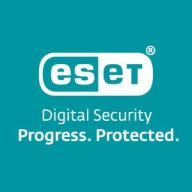

ESET Endpoint Protection Platform and Microsoft Defender for Identity are key players in the cybersecurity space, focusing on endpoint and identity protection, respectively. ESET stands out in threat detection and resource efficiency, while Microsoft Defender integrates well within its ecosystem, excelling in identity protection and analytical capabilities.
Features: ESET Endpoint Protection Platform boasts ThreatSense technology for thorough threat detection, a lightweight antivirus engine, and features like Antispyware, Host-Based Intrusion Prevention System, and a centralized management console. Microsoft Defender for Identity offers comprehensive identity protection, seamless integration with Microsoft 365 applications, advanced threat detection, and extensive monitoring of network activities.
Room for Improvement: ESET users highlight issues like complex uninstallation processes, limited heuristic detection, and lack of iOS compatibility. Pricing structure improvements are needed, especially for virtual machine environments. Microsoft Defender for Identity faces challenges with false positives and the agent installation process in on-premises setups. Enhancements in integration for a smoother user experience and more detailed reporting are also desired.
Ease of Deployment and Customer Service: ESET offers flexible deployment across on-premises, cloud, and hybrid environments, though support can vary by region. Microsoft Defender for Identity, tailored for Microsoft cloud environments, requires Azure integration. While its support is effective, reliance on Microsoft's ecosystem can be limiting outside of it.
Pricing and ROI: ESET provides competitive pricing favorable for small to medium businesses, with a strong ROI in security and resource management. Microsoft Defender for Identity is often bundled with Microsoft licensing, offering cost advantages within Microsoft 365 ecosystems, though pricing complexity depends on specific plans and use cases.
Normally, I cannot give a ten for support of all brands, as it is not always possible to get full support from companies.
The quality of support is very good, but troubleshooting can take time due to complex setups and the need to provide many logs.
Generally, the support is more effective than other providers like Oracle.
In terms of scalability, I can rate it eight or nine out of ten.
In a Microsoft-centric organization, especially with Azure infrastructure and Office 365, Microsoft Defender for Identity is scalable.
In terms of stability, I can rate it at nine out of ten.
Microsoft Defender for Identity is quite robust and built on Azure hyperscale infrastructure, with a 99% availability.
A lightweight version of ESET might be beneficial as many of our clients have older CPUs and RAM.
Reducing false positives is something we've been working on with Microsoft.
One improvement I would recommend is the integration of an admin application within Teams, allowing easy access to attack information on a mobile platform.
There is room for improvement in delivering knowledge to technical users, especially regarding what we can gain from the solution and how to apply it.
The pricing of ESET Endpoint Protection Platform is a bit high compared to other competitors.
the Microsoft Defender Suite is quite expensive, especially when integrated into Sentinel.
Ensuring a fair price according to market standards.
From an organization perspective, using E5 licenses is value for money, especially if Azure and Office 365 are already in use.
The primary purpose is to protect computers from viruses and ransomware.
The seamless integration with other Microsoft solutions within our Microsoft-centric environment is also a major advantage.
The most valuable features of Microsoft Defender for Identity include its automatic remedies, possibilities for avoiding incidents, the privilege manager, and the generation of logs that facilitate a safer environment.
The integration into the Microsoft Defender ecosystem is the most valuable feature of Microsoft Defender for Identity.


ESET Endpoint Protection Platform (EPP) is a cybersecurity solution designed to protect businesses of all sizes against a wide array of cyber threats. Its advanced technologies and user-friendly interface provide robust security for endpoint devices, such as desktops, laptops, and mobile devices, without compromising performance. ESET's approach combines multiple layers of protection, including traditional signature-based detection with advanced heuristic analysis, behavioral monitoring, and machine learning, to effectively counter both known and emerging threats.
ESET's Endpoint Protection Platform is based on a multi-layered defense strategy, which utilizes various technologies like cloud-based scanning, network attack protection, and exploit blockers. This strategy ensures solid protection against malware, ransomware, phishing attacks, and advanced persistent threats (APTs), offering businesses peace of mind regarding their digital security. ESET's platform protects computers, mobile devices, file servers and virtual environments. It’s available as a standalone product and as a part of a wider enterprise cybersecurity bundle, ESET PROTECT Enterprise, which also includes file server security, disk encryption, a cloud sandbox and EDR.
ESET PROTECT Advanced
The ESET PROTECT Advanced provides best-in-class endpoint protection against ransomware & zero-day threats, backed by powerful data security.
Performance and Compatibility
ESET is widely acclaimed for its light system footprint, ensuring that endpoint protection does not come at the expense of performance. This efficiency is crucial for maintaining operational productivity without sacrificing security. Moreover, ESET's solutions are compatible with a wide range of operating systems, including Windows, macOS, Linux, and Android.
Centralized Management
ESET Endpoint Protection Platform is managed via ESET Security Management Center, a centralized management console that provides real-time visibility into on-premise and off-premise endpoints. This simplifies the administration of security policies, streamlines the detection and response processes, and provides detailed reporting capabilities, making it easier for IT professionals to maintain a secure and compliant IT environment.
Microsoft Defender for Identity integrates with Microsoft tools to monitor user activity, providing advanced threat detection and analysis using AI. It enhances proactive threat response and security visibility, making it essential for securing on-premises and cloud environments like Active Directory.
Microsoft Defender for Identity offers comprehensive monitoring and AI-driven user behavior analysis. It detects threats through real-time alerts and identifies lateral movements and entity tagging, ensuring robust security management. With excellent visibility via its dashboard, it supports customized detection rules and seamlessly integrates with SIEM platforms. While SecureScore and SecureScan provide robust environment security, there is room for improvement in cloud security, on-premises application integration, and remediation capabilities. Azure integration is limited, and the administrative interface could be more user-friendly. Users experience frequent false positives, affecting threat detection efficiency.
What key features stand out in Microsoft Defender for Identity?In specific industries such as education and finance, Microsoft Defender for Identity is crucial for securing on-premises Active Directory and Azure Active Directory environments. It effectively detects suspicious activities and manages conditional access policies, offering user and entity behavior analytics, endpoint detection and response capabilities. This helps prevent unauthorized access and strengthens overall security, making it an invaluable asset for organizations aiming to safeguard their digital infrastructure.
We monitor all Advanced Threat Protection (ATP) reviews to prevent fraudulent reviews and keep review quality high. We do not post reviews by company employees or direct competitors. We validate each review for authenticity via cross-reference with LinkedIn, and personal follow-up with the reviewer when necessary.